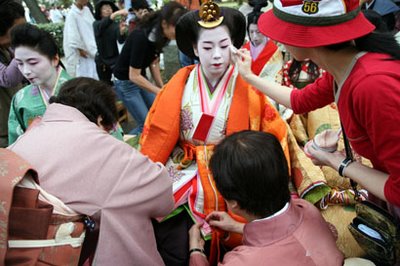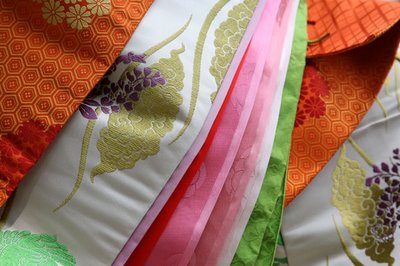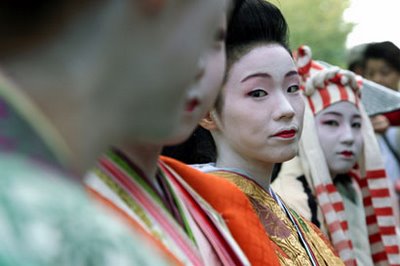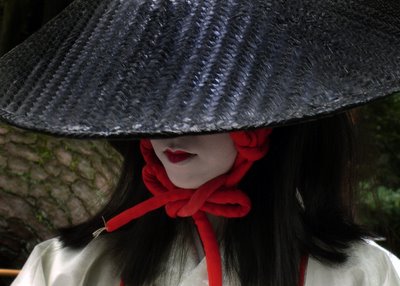Heian Period

Terukoma, geiko of Gion Kobu, as Shizuka Gozen in Kyoto's Festival of Ages.
Lady Shizuka is one of the most famous and celebrated women of Japanese history. Daughter of a shirabyoshi, or court dancer, Shizuka recieved an invitation from the retired Emperor Shirakawa to dance for the gods, hoping that it would bring an end to a long drought. The chants of a hundred Buddhist monks performances by ninety-nine shirabyoshi had proven useless, but Shizuka's graceful movements acheived the desired effect. The Emperor praised her performance, and it was then that she met the hero Minamoto-no-Yoshitsune.
As a brilliant Genji general in the Gempei War (1180-1185), Yoshitsune's success earned him the distrust of his half-brother, Yoritomo, leader of the Genji clan. In 1185, Yoritomo forced his half-brother to flee and live like an outlaw. Four years later, he was betrayed, and forced to commit seppuku (ritual suicide).

Terukoma waits patiently as stylists make a few last minute touch-ups to her carefully styled wig. She holds a tsuzumi, an hourglass-shaped drum originally taught with fox skin. Played with the tips of the fingers over the shoulder, it produces a distinct "pon" sound. The tsuzumi is used in classical Noh and Kabuki theater and is one of the many traditional instruments studied by geiko and maiko.
Shizuka, pregnant with his child, was captured by Yoritomo. Forced to dance for him, he was so charmed that he agreed to spare her life and that of her unborn child-- if it was a girl. Unfortunately, she gave birth to a son, who was soon killed at Yoritomo's order to prevent the child from seeking vengeance for his father's death later in life. Some say that Shizuka was also killed, some that she became a nun, and others that she drowned herself in a river in despair. She has haunted Japanese art and literature, appearing in everything from Kabuki to manga, ever since.






 Makiko, maiko of Gion Kobu, also served as a Lady-in-Waiting to Yodogimi (Suzuko).
Makiko, maiko of Gion Kobu, also served as a Lady-in-Waiting to Yodogimi (Suzuko). Sakiko, another young maiko of Gion Kobu, shades herself with an elaborate fan.
Sakiko, another young maiko of Gion Kobu, shades herself with an elaborate fan.


 Kudara O Myoshin, the wife of a powerful government minister, gained the trust of Emperor Kanmu who honored her with the position of Chief Lady-in-Waiting at the Imperial Court.
Kudara O Myoshin, the wife of a powerful government minister, gained the trust of Emperor Kanmu who honored her with the position of Chief Lady-in-Waiting at the Imperial Court.

 Jidai Matsuri, Kyoto`s Festival of Ages, started as a way to revitalize Kyoto after Japan's capitol moved to Tokyo. It has now grown to include over two thousand participants (Kyoto residents, including Maiko and Geiko) dressed in authentic period costumes from throughout Japan`s history valued at over $25 million.
Jidai Matsuri, Kyoto`s Festival of Ages, started as a way to revitalize Kyoto after Japan's capitol moved to Tokyo. It has now grown to include over two thousand participants (Kyoto residents, including Maiko and Geiko) dressed in authentic period costumes from throughout Japan`s history valued at over $25 million.




 Colors and patterns of the "juni-hitoe" (12 layers- a rather arbitrary number, as some women wore as many as 20) reflected many things, including: rank, seasons, directions, virtues, and elements of the earth as they related to spirits of nature. The multiple layers also helped in staying warm in winter. Eventually, sumptuary laws of the Edo Period standardized the number of layers to five.
Colors and patterns of the "juni-hitoe" (12 layers- a rather arbitrary number, as some women wore as many as 20) reflected many things, including: rank, seasons, directions, virtues, and elements of the earth as they related to spirits of nature. The multiple layers also helped in staying warm in winter. Eventually, sumptuary laws of the Edo Period standardized the number of layers to five.




